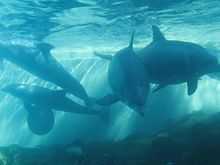| Dolphin Cove |
|---|
|
|
|
|
|
|
| SeaWorld Ohio |
|---|
| Status | Closed |
|---|
| Opening date | 1970 |
|---|
| Closing date | January 2001 (2001-01) |
|---|
|
| General statistics |
|---|
| Attraction type |
Dolphin exhibit |
|---|
| Designer |
SeaWorld |
|---|
Dolphin Cove (which is part of the main attraction Key West) is a SeaWorld attraction, which can be found at all SeaWorld parks and holds about 700,000 US gallons (2,650,000 l) of water. Specifically, Dolphin Cove is located at SeaWorld Orlando, SeaWorld San Diego and SeaWorld San Antonio.
Dolphin Cove was designed to reflect a natural ecosystem and has an underwater viewing area where visitors can watch the dolphins while listening to relaxing music, and hear the dolphin's communications.
The Dolphin Cove habitat is one of the largest dolphin pools in existence, where the visitor can interact with the dolphins. It features 2-foot-high (0.61 m) waves, a sandy beach and an imitation coral reef.
History

The underwater viewing area with the Bottlenose Dolphins at SeaWorld Florida.
When founded in 1964, SeaWorld San Diego was the first of its kind to feature a Dolphin Cove. In 1970, the second park SeaWorld Ohio was built in Aurora, Ohio, near Cleveland; it featured a Dolphin Cove.[1] In 1973, the third Dolphin Cove opened together with SeaWorld Orlando.[2] In 1988, the fourth Dolphin Cove in SeaWorld San Antonio opened its doors.[3] In January 2001, SeaWorld Ohio was sold to Six Flags resulting in the exhibit's closure.
Dolphins

SeaWorld Dolphin Cove - feeding and touching area
Dolphin Cove mainly consists of bottlenose dolphins, one of the most common dolphins. The dolphins are shifted between Dolphin Cove, Dolphin Nursery and Discovery Cove; depending on pregnancies and space availability.
Bottlenose dolphins can be found worldwide, in warm waters such as the Gulf of Mexico.
Throughout the day, visitors can feed the dolphins for a fee.[4] Trainers give informational speeches about the Bottlenose Dolphin.[5]
Criticism
Organizations such as World Animal Protection and the Whale and Dolphin Conservation Society are against the captivity of dolphins and Orcas. Bottlenose Dolphins might not have a shorter life span in captivity (like Orcas) [6] but cannot make much use of echolocation due to sensory deprivation. Small pools and the chlorination of the water are living conditions marked for criticism.
SeaWorld's methods for obtaining animals in the past have also been criticized. SeaWorld's attempt to capture several Orcas in Puget Sound in the early 1970s using powerboats, airplanes and explosives to drive the animals resulted in revoking of all capture permits. Dolphin Captures ended in the late 1980s.[7][8] In 1995, SeaWorld announced that it would no longer capture dolphins and whales from the wild.[9] The animals are now obtained through breeding including artificial insemination, loans, and purchases from other marine parks around the world.[9][10]
References
- ↑ seaworld.com
- ↑ DK Travel : Orlando : SeaWorld Orlando
- ↑ SeaWorld San Antonio
- ↑ Seaworld: What to Do
- ↑ Bottlenose Dolphins
- ↑ J.D. van der Toorn (1999), Survival rate study of marine mammals in captivity, retrieved November 1, 2006.
- ↑ Courtney S.Vail and Denise Risch (2006), Driven by demand, chapter International trade in drive hunt dolphins. Retrieved October 13, 2006
- ↑ Eric de Place and Kathy Fletcher (2005), Increasing orca population is a sign we can save the Sound, article retrieved November 1, 2006.
- ↑ 9.0 9.1 Animal Liberation Inc. (date unknown), Capture for entertainment, article retrieved March 23, 2007.
- ↑ Captive Orca's dying to entertain you
External links